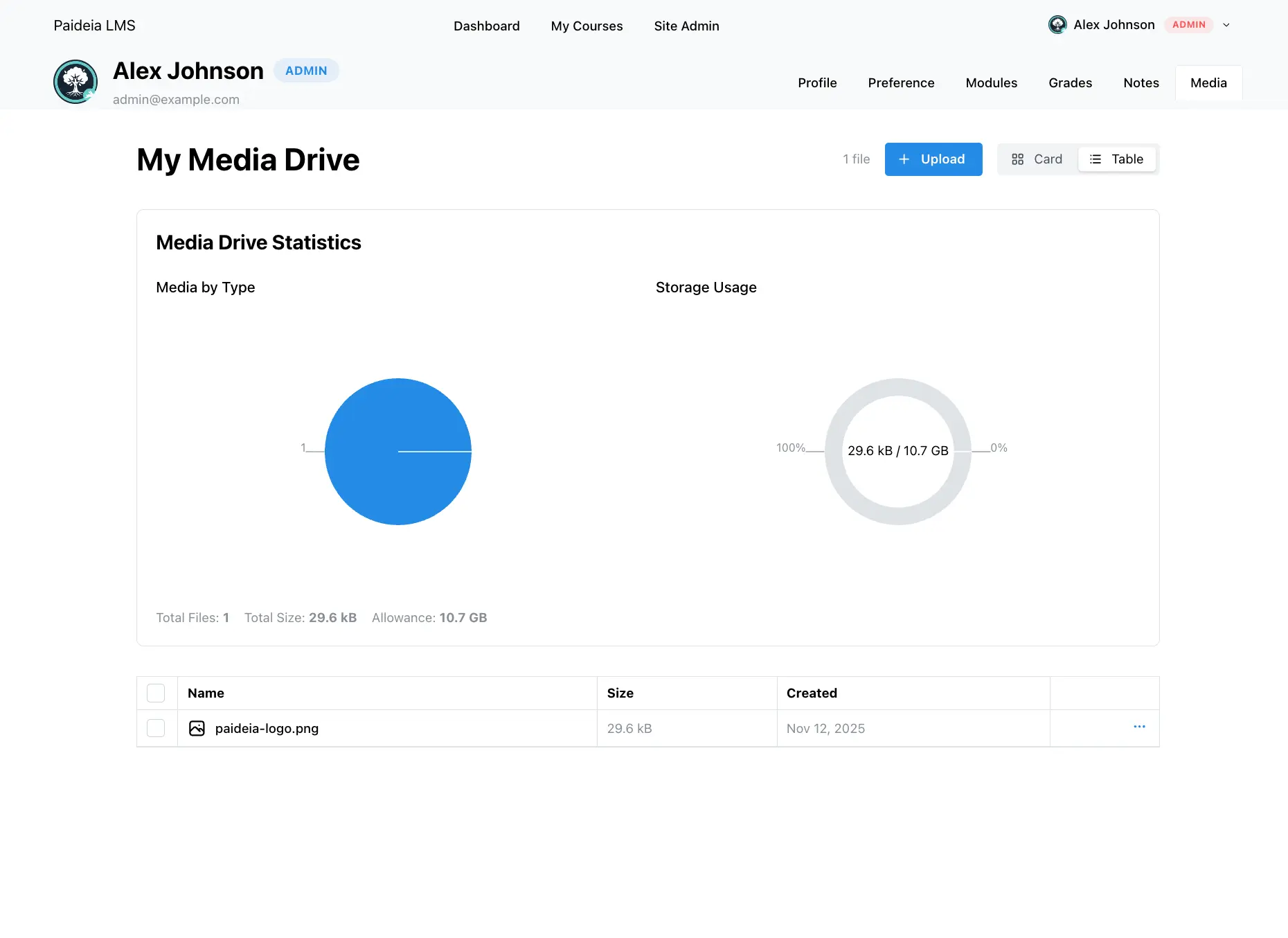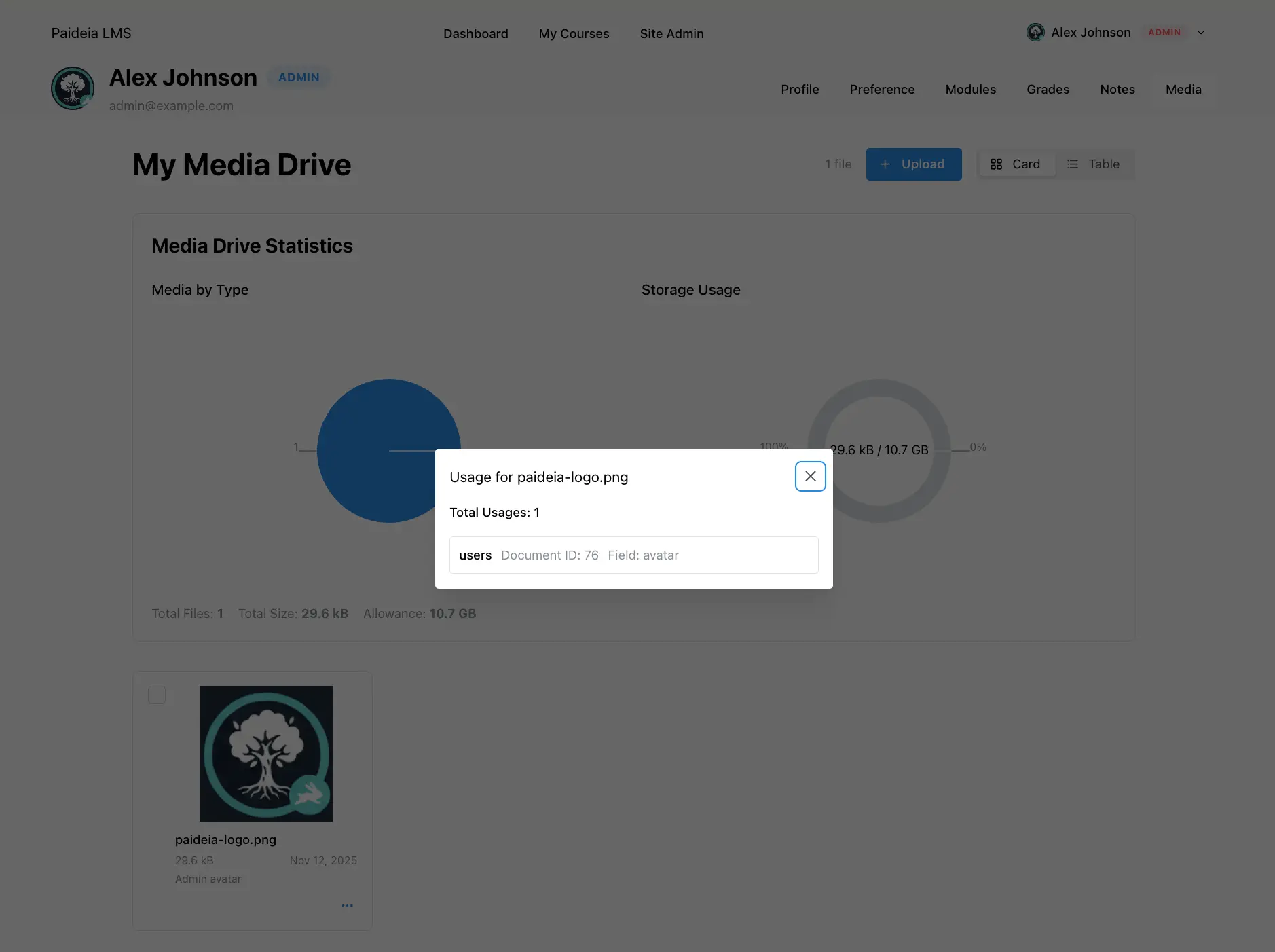Media Management
本頁內容尚未翻譯。
The Media Drive is your personal storage space for all media files in Paideia LMS. Every file you upload is associated with your account, allowing you to view, organize, download, rename, and delete your media files. The Media Drive serves as the foundation for media uploads across assignments, notes, and other content types.
Why Paideia Media Drive is Unique
Section titled “Why Paideia Media Drive is Unique”Paideia’s built-in Media Drive is a powerful feature that sets it apart from traditional Learning Management Systems. Unlike most LMS platforms that rely on external storage integrations (such as OneDrive, Google Drive, or Dropbox), Paideia provides a fully integrated media management system built directly into the platform.
Built-In Integration
Section titled “Built-In Integration”Traditional LMS Limitations:
- Most LMS platforms require integration with external cloud storage services
- External drives are separate systems from the LMS
- Permission and access control issues often arise when integration is not properly configured
- Students and instructors face difficulties accessing files due to permission mismatches
- File sharing becomes complex when crossing system boundaries
Paideia’s Advantage:
- Native Integration: The media drive is built directly into the LMS, not a separate system
- Automatic Permissions: All permissions and access control are automatically configured by the system
- No Permission Issues: Since everything is within the same system, there are no cross-system permission conflicts
- Seamless Access: Students and instructors can access files without dealing with external authentication
- Unified Experience: All media operations work consistently across the entire platform
Virtually Unlimited Storage
Section titled “Virtually Unlimited Storage”Paideia uses S3-compatible storage (such as AWS S3, MinIO, or other S3-compatible services), which provides:
- Scalable Storage: Storage capacity scales with your needs
- Cost-Effective: Pay only for what you use
- Reliable: Enterprise-grade storage infrastructure
- No Hard Limits: Unlike external integrations with storage quotas, Paideia’s S3-based storage is virtually unlimited
Administrators can configure storage quotas per user if needed, but the underlying storage system can scale to accommodate any amount of data.
Comprehensive Management
Section titled “Comprehensive Management”For administrators, Paideia provides detailed statistics and management tools:
- Storage Analytics: See which users are using how much storage
- File Type Analysis: Understand what types of files consume the most storage
- Usage Tracking: Monitor media file usage across the platform
- Orphaned File Detection: Identify and clean up unused files
- System-Wide View: Manage all media files from a single interface
These statistics are invaluable for:
- Capacity Planning: Understanding storage growth trends
- Resource Management: Identifying users with high storage usage
- Cost Optimization: Finding opportunities to optimize storage usage
- System Health: Monitoring overall system media usage
Overview
Section titled “Overview”The Media Drive provides:
- Personal Storage: All your uploaded media files in one place
- Multiple View Modes: Card view and table view for different preferences
- File Operations: Upload, download, rename, and delete files
- Storage Quota: Visual display of your storage usage and limits
- Media Preview: Inline previews for images, audio, video, and PDF files
- Usage Tracking: See where your media files are being used before deletion
- Batch Operations: Select and delete multiple files at once
Accessing Your Media Drive
Section titled “Accessing Your Media Drive”There are two ways to access your Media Drive:
Method 1: Via User Menu
Section titled “Method 1: Via User Menu”- Click on your user profile in the top navigation bar
- Select “Media” from the dropdown menu
- You’ll be taken to your Media Drive page at
/user/media
Method 2: Via User Layout Tabs
Section titled “Method 2: Via User Layout Tabs”- Navigate to any user profile page (your own or another user’s)
- Click on the “Media” tab in the user layout navigation
- The Media Drive page will display all your media files

Uploading Files
Section titled “Uploading Files”To upload media files to your drive:
- Navigate to your Media Drive page
- Click the ”+ Upload” button in the header
- Select one or more files from your computer
- The files will be uploaded automatically
Supported File Types
Section titled “Supported File Types”The Media Drive accepts various file types including:
- Images: JPEG, PNG, GIF, WebP, SVG
- Audio: MP3, WAV, OGG, M4A
- Video: MP4, WebM, OGG, MOV
- Documents: PDF, DOC, DOCX, XLS, XLSX, PPT, PPTX
- Text: TXT, MD
- Archives: ZIP, RAR, 7Z
Upload Limits
Section titled “Upload Limits”Upload file sizes are limited by the site-wide upload limit configured by administrators. If you attempt to upload a file that exceeds the limit, you’ll see an error message indicating the maximum allowed file size.
Viewing Media
Section titled “Viewing Media”The Media Drive offers two view modes for displaying your files:
Card View
Section titled “Card View”Card view displays your media files as visual cards with:
- Thumbnails: Image previews or file type icons
- File Information: Name, size, creation date
- Quick Actions: Checkbox for selection, action menu (three dots)
- Inline Previews: Audio and video players for media files
Table View
Section titled “Table View”Table view displays your media files in a data table format with:
- Columns: Filename, size, created date, actions
- Sortable Columns: Click column headers to sort
- Row Selection: Checkboxes for selecting multiple files
- Compact Display: More files visible at once
Switch between views using the “Card” and “Table” toggle buttons in the header.
Previewing Media
Section titled “Previewing Media”The Media Drive supports inline and full-size previews for various file types:
Inline Previews
Section titled “Inline Previews”- Images: Thumbnails displayed in card view
- Audio: Audio player with controls in card view
- Video: Video player with controls (max 150px height) in card view
Full-Size Preview Modal
Section titled “Full-Size Preview Modal”Access the preview modal by clicking the “Preview” option in the action menu (three dots) on any media file. The modal supports:
- Images: Full-size image with proper scaling
- Audio: Full audio player with all controls
- Video: Full video player (max 80vh height) with all controls
- PDF: Browser-native PDF viewer via iframe
Downloading Files
Section titled “Downloading Files”To download a media file:
- Click the action menu (three dots) on the file card or table row
- Select “Download”
- The file will download with its original filename
Files are downloaded with proper Content-Disposition headers to ensure the correct filename is used.
Renaming Files
Section titled “Renaming Files”To rename a media file:
- Click the action menu (three dots) on the file
- Select “Rename”
- Enter the new filename in the modal dialog
- Click “Save” to confirm
The rename operation updates both the database record and the S3 storage file, ensuring consistency across the system.
Deleting Files
Section titled “Deleting Files”You can delete files individually or in batches:
Single File Deletion
Section titled “Single File Deletion”- Click the action menu (three dots) on the file
- Select “Delete”
- Confirm the deletion in the dialog
- The file will be removed from both the database and S3 storage
Batch Deletion
Section titled “Batch Deletion”- Select multiple files using the checkboxes (card view) or row selection (table view)
- Click the “Delete Selected” button that appears
- Confirm the deletion in the dialog
- All selected files will be deleted
Storage Quota
Section titled “Storage Quota”The Media Drive displays your storage usage with a visual donut chart:
When Storage Limit is Set
Section titled “When Storage Limit is Set”- Used Storage: Shows how much storage you’ve used
- Available Storage: Shows how much storage remains
- Chart Label: Displays “X / Y” (used / limit)
- Allowance Text: Shows your total storage allowance
When Storage is Unlimited
Section titled “When Storage is Unlimited”- Used Storage: Shows only how much storage you’ve used
- Chart Label: Displays only the used amount
- Allowance Text: Shows “Unlimited”
The storage quota is configured by administrators and applies to all media files you upload, including those used in assignments, notes, and other content.
Media Usage Tracking
Section titled “Media Usage Tracking”Before deleting media files, you can check where they’re being used:
Viewing Media Usage
Section titled “Viewing Media Usage”- Click the action menu (three dots) on any media file
- Select “Show Usage”
- A modal will display all locations where the file is referenced
Usage Information
Section titled “Usage Information”The usage modal shows:
- Total Usages: Number of places the file is referenced
- Usage Details: Collection name, document ID, and field path for each usage
Common usage locations include:
- User Avatars:
userscollection,avatarfield - Course Thumbnails:
coursescollection,thumbnailfield - Assignment Attachments:
assignment-submissionscollection,attachments[].filefield - Discussion Attachments:
discussion-submissionscollection,attachments[].filefield - Content Media:
courses,pages,notescollections,mediarelationship field
Deletion Protection
Section titled “Deletion Protection”If you attempt to delete a media file that is still in use, the system will:
- Check for all usages before deletion
- Prevent deletion if any usages are found
- Display an error message with the media ID and usage count
- Require you to remove all references before deletion
This protection prevents accidental deletion of files that are still referenced in your content.

Best Practices
Section titled “Best Practices”Organizing Your Media
Section titled “Organizing Your Media”- Use Descriptive Filenames: Name files clearly to make them easy to find
- Upload as Needed: Upload files when you need them, rather than in bulk
- Check Usage Before Deleting: Always check usage before deleting files
- Monitor Storage: Keep an eye on your storage quota to avoid hitting limits
File Management
Section titled “File Management”- Regular Cleanup: Periodically review and delete unused files
- Batch Operations: Use batch deletion for cleaning up multiple files at once
- Preview Before Use: Use the preview feature to verify files before using them in content
Storage Management
Section titled “Storage Management”- Optimize File Sizes: Compress images and videos when possible
- Use Appropriate Formats: Choose file formats that balance quality and size
- Monitor Quota: Check your storage usage regularly to stay within limits
Troubleshooting
Section titled “Troubleshooting”Cannot Upload Files
Section titled “Cannot Upload Files”If you cannot upload files:
- Check that your file size is within the upload limit
- Verify that the file type is supported
- Ensure you have available storage quota (if limits are set)
- Check your internet connection
- Contact your administrator if issues persist
Files Not Appearing
Section titled “Files Not Appearing”If uploaded files don’t appear:
- Refresh the page
- Check that you’re viewing the correct user’s media drive
- Verify that the upload completed successfully
- Check browser console for errors
Cannot Delete Files
Section titled “Cannot Delete Files”If you cannot delete files:
- Check the usage modal to see where the file is referenced
- Remove all references to the file before attempting deletion
- Verify you have permission to delete the file (you can only delete your own files)
- Contact your administrator if you need to delete files referenced by others
Storage Quota Issues
Section titled “Storage Quota Issues”If you’re hitting storage limits:
- Check your current usage in the storage chart
- Delete unused files to free up space
- Contact your administrator to request a quota increase
- Consider optimizing file sizes before uploading
Related Features
Section titled “Related Features”- Site Policies - Learn about storage quotas and upload limits
- Admin Media Management - Administrators can view and manage all system media
- User Overview - Learn about user roles and permissions
